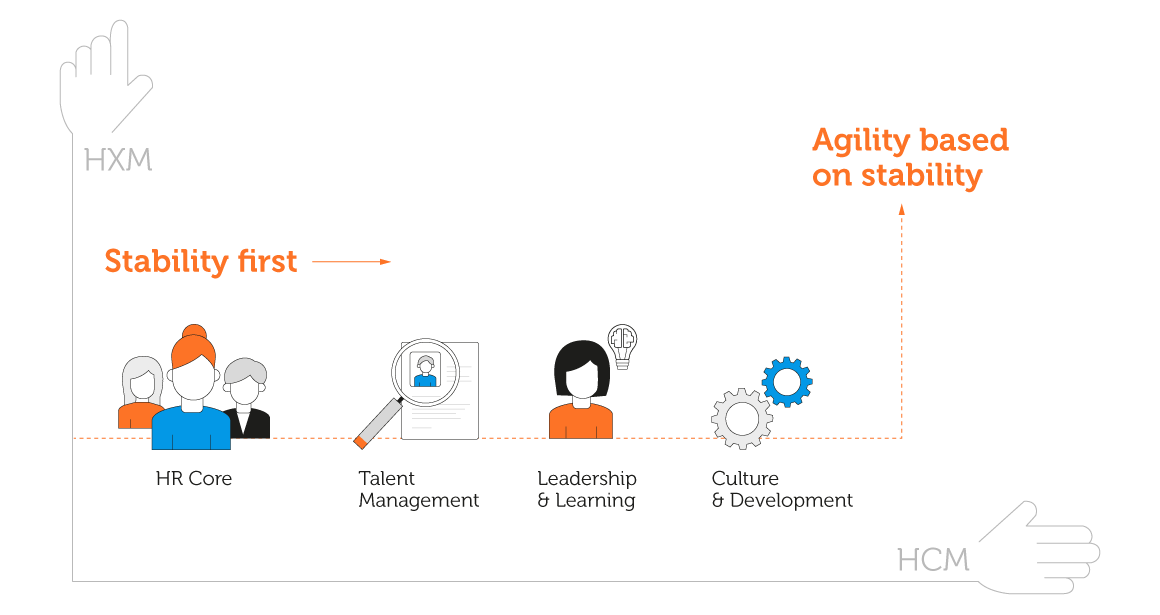HR transformation – the dawn of a new era in HR excellence
Companies have a competitive advantage when they make the most of individual and organisational skills. HR has a crucial role to play as a strategic partner. Only by repositioning themselves digitally and automating complex administrative processes can HR departments create the necessary freedom for their new role. Ambidexterity is in demand: this means that the HR department of the future will have to act ambidextrously - ensuring stability through stable processes and services on the one hand, and responding to change with agility on the other. In the VUCA world, it is the latter factor in particular, and therefore digitalisation, that is becoming increasingly important. However, for the transformation to an ambidextrous player and to HR 4.0 to be successful, it will require buy-in from stakeholders, the development of a digital mindset, the necessary digital tools and solutions, and decisive action from HR leaders in terms of a new HR strategy.

A company’s success hinges on its business model, patents, licenses, new technologies and – last, but by no means least – on its workforce. The skills of individual employees and, most importantly, the collective capabilities of the organization are crucially important. If a company can make the most of both, it will gain an edge on the competition.
The HR team plays a decisive role in this regard. Not only is it the department that finds the ideal people for key positions, it is also a strategic partner that sets the tone for staff development and devises strategies for effectively distributing knowledge – particularly with a view to strengthening digital know-how and skills in the company. What’s more, it is perfectly placed to cleverly manage HR planning and the associated skills risks.
Digitalization creates greater scope for action
This is precisely where HR departments often fall short. Surveys and studies on this subject have shown time and again that staff simply don’t have the time to take care of these tasks because they’re fully occupied with their day-to-day operational work. This raises an important question for HR executives – how do you fulfill one role without neglecting the other? Digitalization is the key. To offer an analogy, digitalization makes it easier to take care of operational tasks in the same way as sharpening an axe makes it easier to chop wood – processes run faster and more effectively. The more successfully an HR department can implement its digital makeover and automate complex administrative processes, the more scope it will have to perform its role as a strategic partner and advisor.
However, “digital HR” means even more for HR executives than just freeing up resources. By putting in place harmonized and digitalized basic HR processes, they are also establishing data integrity and efficiency, which leads to dependable master data management. In short, they are maximizing the stability of their management and administrative processes through digitalization.
They can then use the capacities freed up by their digital HR transformation to perform their role as an agile player and highly skilled HR business partner. This will enable them to actively drive HR transformation and innovation in the company by consistently deploying data-based HR solutions and thus meeting the expectations of their target group, their own staff and potential new specialists.
The principle of ambidexterity
All these points make it clear that the human resources departments of the future will need to play two roles to perfection. The first is that of a service provider with a good grip on all the day-to-day operational business from recruiting to remuneration management. The second is that of a strategist and innovator, rolling out HR digitalization step by step.

Fast & agile HXM innovations based on a stable and integrated HCM backbone - technologically and organizationally
The transformation process can be clearly illustrated in a graph. The various modules of operational business are listed along the x axis. The more advanced the level of digitalization is, the more stable the processes are and the simpler the task of management. If the operational side is running smoothly, it’s time to ramp up the agility – an approach that often involves collaboration with other functions to facilitate innovation, not just in HR but across the company as whole.
So, what does all that mean for the skillset in HR? Experts talk about the concept of ambidexterity. The HR department of the future will have to use both its “hands” – the left one to keep a handle on stability with rock-solid master data management and the right one to ensure it achieves that all-important agility.
A VUCA virtuoso
This trend underscores the growing importance of agility. Advancing digitalization is forcing the HR department to change and to gradually digitalize HR services. Just like the company as a whole, it is pursuing HR transformation in an effort to strategically realign itself in a world shaped by Volatility, Uncertainty, Complexity and Ambiguity. Against the backdrop of VUCA, digitalization opens up entirely new opportunities to meet the needs and expectations of your target group – staff and potential new talent – and to offer personalized solutions.
After all, in the struggle to attract talented new employees, it is essential that HR staff have digital know-how and can tailor their efforts to the relevant target groups. They need to follow the trend, position themselves on appropriate portals and careers sites and engage with their contacts on a level, digital, playing field. When trying to attract the ideal candidates, HR specialists who have finely honed social media expertise are more likely to hit their targets than someone hiding behind an anonymous e-mail address, collecting and evaluating applications as part of a classic approach. All the same, social media smarts go well beyond just showing your face. It is also about knowing what kind of platforms potential employees are using and, as a recruiter, ensuring your company can also be found using the right keywords for jobs.
Furthermore, digital skills are helpful in other areas besides recruiting. For example, digital technologies, such as a Learning Experience Platform (LXP), can be used to drive staff development and take learning to a whole new level. An LXP gives users learning experiences they would never have thought possible. They receive recommendations tailored specifically to the kind of work they are doing. Using artificial intelligence, the very best platforms will identify the information or know-how that is required and provide this knowledge at precisely the right moment.
Zeroing in on the target group
The examples make one thing clear – if you want to be a successful HR executive these days, you have to depend on digitalization. After all, it gives you the chance to get closer than ever to your target group, helps you understand their expectations and shape experiences to suit relevant needs. Indeed, that is precisely what staff and applicants are looking for today.
Experts refer to this side of HR as human experience management. It centers on optimizing the employee experience and creating an environment where staff enjoy working – from their very first day on the job. They need to feel valued, work with state-of-the-art IT, have frictionless access to the system and know there is someone who can answer their questions. From an HR perspective, that means thinking and acting across different functions. As in the case of onboarding, for example, it is about collaborating with the IT department and facility management team and putting the employee at the heart of everything.
Fundamentally, the challenge is to anticipate the expectations and needs of staff. After all, they don’t want to be seen as anonymous workers or human capital, but as people – individuals – whose contribution is valued and who want to better themselves on a professional and personal level. They also aspire to having a meaningful purpose, flexible employment models, a good work-life balance and a daily routine that follows the principles of “New Work”. HR can be a pathfinder for “Work 4.0”, create digital structures for the organization, inject some dynamism into the business and break new ground for human resources.
Opening doors with your mindset
Before an HR department can become an ambidextrous player and usher in HR 4.0, it needs to secure the acceptance of everyone involved and bolster its credibility. The only way to achieve change and successfully transform into a digital organization is to work with people and never against them. From the reverse perspective, that means the transformation has to be desired and cannot be imposed from the top down. The benefits need to be clear and transparent to people both inside and outside the HR team. What’s more, digital HR transformation isn’t an IT project – it needs to be viewed holistically, as a kind of journey. Making an organization more digitally mature is not just about processes and technologies, but also about roles, structures and governance – even down to attitudes and culture. Close cooperation with internal customers, employee representative bodies and other disciplines such as business development and IT is indispensable.
Adopting this kind of approach can effectively eliminate anxieties and make the HR transformation a success. Over time, changes in behavior can culminate in a new attitude, which in turn ultimately gives rise to new ways of working that are rooted in the principles of agility, promote interdisciplinary working, bring on board a whole range of people from the start and can be used to drive forward innovation faster than before in line with the “fail early, fail fast” principle.
Start with stability, finish with freestyling
Anyone who adopts a holistic approach to HR transformation will surely come to the conclusion that stability must come first. Consequently, the top priorities in any company must be reliable master data management and smooth-running basic processes. Without these, all credibility will be lost and any suggestion regarding digital innovation – no matter how “cool” it might be – will fall on deaf ears. In practical terms, this means all operational activities need to be safeguarded by a stable IT backbone, often in the form of an HCM suite (see graphic). IT solutions can be added to this suite to open up whole new perspectives for HR in terms of agility and human experience management.
The time is ripe for change
Ultimately, HR software and solutions are available for virtually the entire HR landscape. What really matters now is that HR executives are decisive and resolute. As part of a new HR strategy and acting as transformation partners, they can drive and actively shape their company’s digital change. The more “digitally mature” the HR department is, the more convincing the function can be when it seeks to influence the company, speed up change and promote a corporate culture in which digital transformation is a central element.
The pandemic has shown us how important and valuable digital solutions are. They ensure continuity and stability when face-to-face contact and physical presence are not possible. Now is the hour for digital transformation, and the HR function is being called on as a partner in this process. Are you equipped to meet this challenge?




